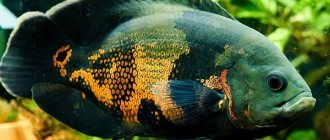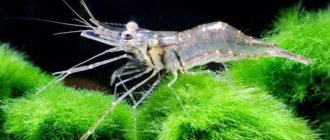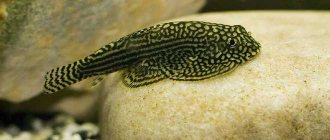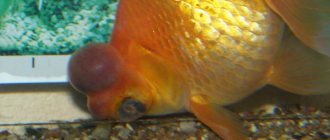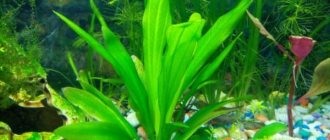Tetraodon mbu or cobblefish Tetraodon mbu is widespread in the Congo River basin and Lake Tanganyika. The name "Mbu" is pronounced "umbu" in local African dialects, meaning "cobblestone". In the market, this type of pufferfish is called the Gold Ringed Puffer or the Reticulated Pufferfish. Each individual of the species has a special pattern consisting of dark mesh rings running over the golden body. In nature, the color of Mbu perfectly hides it on the ground. Even an adult in a river can be mistaken for a cobblestone lying on a sandy bottom.
This species of pufferfish is the largest among other freshwater tetraodons, adults reaching 67 cm in length. Their main food is crustaceans and bivalves. The reason the Mbu can feed on such solid food is due to the structure of its beak. All tetraodons have 4 fused teeth; in large species, the teeth form something like a beak. The dental plates are unusually strong; they grow throughout the life of the pufferfish, so in order to wear them down, it needs to constantly feed on food containing a hard carapace or shell. Otherwise, the teeth will reach such a length that they will not allow swallowing any food.
In its natural habitat, the Mbu swims with the current along the sandy bottom, hunting for prey buried in the sand. Its independently rotating eyes provide a wide field of vision that helps it locate food items. It is unknown whether Mbu relies on sight alone when hunting buried living creatures. Then how does it detect the smallest movements of prey? In an aquarium you can often observe how individuals of this species rummage in the sand. There is probably an exploratory aspect to their behavior, or their sense of smell contributes.
In times of danger, the pufferfish is able to swell. Like a porcupine, its body is covered with spines, which act as a deterrent to predators.
Once the mouth is filled with water, the large muscles at the base of the oral valve are stretched, which then prevents backflow. While the movement of water through the teeth back into the environment is blocked, a "piston" mechanism located at the base of the larynx lifts water into the esophagus and stomach.
Tetraodon Mbu (photo: www.pbase.com/pschia/image/34859837).
The absence of a rib cage or pelvic bones and very flexible spines allow the pufferfish to swell to a considerable size while small muscles under the skin expose the spines.
Another interesting feature of pufferfish, including Mbu, is the presence of a toxin in their body. Marine species accumulate tetrodotoxin, and freshwater species accumulate saxitoxin. Individuals are not able to produce it, but they feed on poisonous crustaceans and mollusks. In particular, marine species eat crustaceans, which in turn feed on toxic Pseudoalteromonas bacteria. Fans who keep Mbu at home should not worry about this, because poisoning can only occur by eating poisonous fish meat. In addition, in an aquarium, the diet for Mbu is non-toxic food items, which leads to detoxification of the body.
Unique to tetraodons is their mode of movement, which closely resembles a helicopter or airplane. While other fish simply swim in a straight line, pufferfish move slowly, but can also maneuver quickly, which allows them to detect and capture prey. Forward movement is carried out by small pectoral fins, while the caudal fin is used only for sharp jerks. This method allows individuals to rotate in place. Tetraodons are careful hunters; they will not fly past their prey like a dart; on the contrary, the fish will slowly search for crustaceans and mollusks hiding in the ground.
Little is known about the Mbu's natural habitat, their sex differences, and reproduction. All specimens presented on the market are wild and come straight from the Congo to the buyer. Being subjected to exhausting transportation, the appearance of the fish can vary dramatically from individual to individual.
Mbu caught in Ubangi, the main right tributary of the Congo River in Central Africa. Weight approximately 2 kg, length - 50 cm. 2006 (photo: By John Friel, flickr.com).
Tetraodon Mbu (photo: www.kugelfischwelt.de).
Description
In a calm state, the pufferfish has an elongated, pear-shaped body with expressive round eyes and a round mouth. The belly is rounded, extending into a small tail, the surface of the body is soft and smooth. The pectoral fins are located on the sides near the gill covers and guide the fish: with their help, the tetradon can swim not only forward, but also backward.
A swollen fish resembles a pincushion: the smooth surface of the body is covered with spines. The tetraodon usually swells when taken out into the air. After returning to the aquarium, it flounders helplessly on the surface for a few more seconds, then gradually acquires its usual body shape.
Tetraodon mbu Tetraodon mbu
11602
11603
11604
11605
11606
11607
11608
11609
11610
11611
Tetraodon mbu is widespread in the Congo River basin and Lake Tanganyika. The name "Mbu" is pronounced "umbu" in local African dialects, meaning "cobblestone". In the market, this type of pufferfish is called the Gold Ringed Puffer or the Reticulated Pufferfish. Each individual of the species has a special pattern consisting of dark mesh rings running over the golden body. In nature, the color of Mbu perfectly camouflages it; even an adult in a river can be mistaken for a cobblestone lying on a sandy bottom. Tetradon mbu has an ovoid body that tapers sharply towards the tail; the bones of the lower and upper jaws are connected to each other and form cuts visible from the outside and similar to 4 large teeth. This species of pufferfish is the largest among other freshwater tetraodons, adults reaching 75 cm in length. They feed mainly on crustaceans and bivalves. The reason the Mbu can feed on such solid food is due to the structure of its beak. All tetraodons have 4 fused teeth; in large species, the teeth form something like a beak. The dental plates are unusually strong; they grow throughout the life of the pufferfish, so in order to wear them down, it needs to constantly feed on food containing a hard carapace or shell. Otherwise, the teeth will reach such a length that they will not allow swallowing any food.
In its natural habitat, the Mbu swims with the current along the sandy bottom, hunting for prey buried in the sand. Its independently rotating eyes provide a wide field of vision that helps it locate food items. It is unknown whether Mbu relies on sight alone when hunting buried living creatures. In an aquarium you can often observe how individuals of this species rummage in the sand. There is probably an exploratory aspect to their behavior, or their sense of smell contributes.
In times of danger, the pufferfish is able to swell. Like a porcupine, its body is covered with spines, which act as a deterrent to predators. Once the mouth is filled with water, the large muscles at the base of the oral valve are stretched, which then prevents backflow. While the movement of water through the teeth back into the environment is blocked, a "piston" mechanism located at the base of the larynx lifts water into the esophagus and stomach. The absence of a rib cage or pelvic bones and very flexible spines allow the pufferfish to swell to a considerable size while small muscles under the skin expose the spines.
Another interesting feature of pufferfish, including Mbu, is the presence of a toxin in their body. Marine species accumulate tetrodotoxin, and freshwater species accumulate saxitoxin. Individuals are not able to produce it themselves, but they feed on poisonous crustaceans and mollusks, which, in turn, feed on toxic Pseudoalteromonas bacteria. Fans who keep Mbu at home should not worry about this, because poisoning can only occur by eating poisonous fish meat. In addition, in an aquarium, the diet for Mbu is non-toxic food items, which leads to detoxification of the body.
Unique to tetraodons is their mode of movement, which closely resembles a helicopter or airplane. While other fish simply swim in a straight line, pufferfish move slowly, but can also maneuver quickly, which allows them to detect and capture prey. Forward movement is carried out by small pectoral fins, while the caudal fin is used only for sharp jerks. They can hover in the water or rotate in place.
To maintain the health of this type of fish, their diet must contain animals with hard shells. Young individuals can be fed land snails, lake needle snails and other snails. Large tetradons are able to feed on squid, crabs, freshwater crayfish and shrimp.
Kinds
- Green tetradon is a common aquarium variety. Can live in fresh, slightly salted water. Color – yellowish-green transverse stripes, irregularly shaped spots, etc. Dimensions in nature are 10-16 cm, in a home aquarium – 6-7 cm. The older the river tetradon, the more aggressive it is;
- The dwarf tetradon is a truly unique fish: it not only can become spherical, but also changes color depending on conditions. The body of the fish is yellow, covered with dark spots of irregular shape. Adults rarely grow more than 5 cm. Due to its small size, it is non-aggressive towards other inhabitants, although it will not allow itself to be offended. The dwarf tetradon's favorite pastime is hunting for snails;
- Red-eyed tetradon, carinotetraodon lorteti - differ from typical representatives by red eyes and sensitivity to water quality. In other respects, they are also aggressive, capricious and secretive, therefore they are most often kept by connoisseurs of tetraodons;
- Tetradon nigroviridis is a large representative, growing up to 15 cm (with the average size of tetradons being 7-10 cm). The color is spotted. The fish brings a lot of trouble to the neighbors in the aquarium with its quarrelsome disposition, habit of digging up something and protecting the territory. Keeping with other fish is not recommended;
- Zebra tetraodon - the body is covered with many stripes on a light background, the abdomen is plain. In character and content it is similar to nigroviridis;
- The eight tetradon is an aggressive species, does not get along with other fish, and does not tolerate attacks on its life. Appearance: There are subtle yellow patterns on the black surface. It is better to keep a maximum of a couple of these fish in an aquarium, without neighbors. They rarely attract keen interest among aquarists: figure-eight tetradons are secretive, sedentary and lead a predominantly nocturnal lifestyle. By the way, this may be why tetradons of this breed live long: up to 18 years in captivity;
- Tetraodon mbu is a huge predator, growing up to 70 cm. Unlike other tetraodons, it is practically not yellow in color. Rarely kept by aquarists not only because of its size, but also because the fish has a quarrelsome character. At the same time, Mbu are very smart and quickly get used to their owner;
- Tetraodon leopard - has a color similar to the fur of a leopard: round dark spots on a light yellow background. These fish are non-aggressive, grow up to 10 cm (males are slightly smaller), and are quite active during the day. They live in captivity up to 10 years;
- Tetraodon Thai - the fish is colored with dark olive shades on top and light underneath. There are dark spots, traditional for pufferfish, all over the body. In the tail area there is a round ocellated spot with a red core. Females are plumper, males are smaller and more richly colored. Vicious fish, suitable only for species aquariums;
- Tetradon fahaka, African tetraodon are extremely aggressive fish and difficult to keep in aquariums. Their sizes are up to 45 cm. It is acceptable to keep alone as a pet: the fahaka easily accustoms itself to hands and recognizes its owner;
- Tetraodon lineatus is a tough fish that is difficult to keep in an aquarium. The black and yellow patterns on the body resemble a labyrinth.
Care and maintenance of tetradon
Tetradons are a type of fish that do not need much space to keep them. For a small flock, a two-bucket aquarium will be enough. To roughly understand exactly how much water is needed for fish, calculate the ratio - three liters per fish.
And exclusively fresh water, you need to carefully monitor its quality. Since the fish recently came to us, they have not yet been fully studied. To avoid their death, the water must be free of ammonia and nitrate compounds, and no salt.
Since baby tetradons are big fans of hunting snails. After eating their prey, they leave a lot of waste at the bottom of the aquarium, which over time begins to rot.
The photo shows the teeth of the tetradon, which are very strong
You need to clean it well and often by installing powerful filters. Then make sure that the filters do not create a large current. It is almost impossible for dwarf tetradons to overcome it. And change one third of the water daily.
The water temperature for their habitat should be within twenty-five degrees Celsius. Cover the bottom of the aquarium with sand from the river, mixed with small pebbles. Plant a lot of greenery, the fish love it very much. And in some places of the aquarium, make dense plantings so that they can hide there.
These fish can exist in any light. But the brighter it is, the more saturated the color of dwarf tetradons stands out. One compressor can completely saturate aquarium water with oxygen.
How to keep tetraodon
In order for the bubble fish to feel comfortable, it needs to create favorable conditions. They consist in selecting the right aquarium, equipment, design and regular care for the quality of water and cleanliness of the soil.
Arrangement of the aquarium
- Volume – from 150 l. The minimum allowable is from 110 l. If the fish has neighbors, then the larger the volume, the more comfortable it will be for all inhabitants. The exception is dwarf species of tetradons; tanks from 50 liters are suitable for them;
- Soil is very important for tetradons. Since these are voracious fish, waste products appear in large quantities. The soil helps the water stay clean longer. Fraction – any, ideally 3-5 or 5-7 mm;
- Filtration is extremely important to keep these fish healthy. Therefore, special attention should be paid to the choice of filter;
- Aeration – moderate, round the clock;
- Lighting – dim, subdued;
- Decor for tetraodons is unimportant. You can use any design elements: stones, driftwood, ceramic pipes. It will be nice if the tetradon can find a secluded place among the decor and hide. For some species, grottoes are a necessary measure;
- Living plants are welcome as they create secluded corners. It is better to plant them denser so that the plants form thickets;
- A lid on the aquarium is desirable.
Water parameters
- Temperature 23-28°C, depending on the type;
- Hardness 2-19°;
- Acidity 6.5-7.5 pH.
Maintenance and care
Water pollution must not be allowed, therefore:
- Mandatory regular cleaning of the soil, timely washing of the filter;
- Weekly change of 1/4 volume of water;
Content
- 1 Description
- 2 Conditions of detention
- 3 Behavior
- 4 Food
- 5 Reproduction
Source: www.aquariaveldhuis.nl
Source: www.lode.biz
- Other names: Giant Tetraodon, Tetraodon Mbu, Mbu pufferfish.
- Origin: Africa.
- Size: up to 67 cm.
- Temperature: 25-28 °C.
- Water parameters: pH 7.5–8.5, dkH 12–20 °.
- Content difficulty: high.
What to feed tetradon
Fish dog is another unofficial name in the description of tetradons. They are very voracious, many eat literally everything that moves. Therefore, it is recommended to occasionally introduce small live fish into an aquarium with predators, which are considered a delicacy by tetradons.
The main food is live (fresh and frozen):
- Shellfish in shells and without: shrimp, squid, snails;
- Bloodworm;
- Worms;
- Koretra.
To diversify the diet, once a week you can feed it with chopped beef heart or liver. Feeding occurs once a day, six days a week.
Compatibility with other fish
In fact, tetradons have individual characters. But yellow tetradons are considered more active and aggressive . They, of course, need to be kept only in a separate aquarium. Otherwise, the fish adjacent to the dwarfs will be bitten and nipped.
But there is no need to despair, these fish can be kept in whole schools, they do not need large volumes of water. Introduce snails and shrimp with them. True, these predators will quickly hunt them. If possible, set aside a separate container in the house for breeding snails.
Behavior and Compatibility
Since most species are aggressive, it is preferable to keep them in a mono-species aquarium. Even the calmest representatives will only be approached as neighbors by large, mobile predators or some amphibians. At home, tetradons can even be aggressive towards each other.
The ball fish hunts very brutally: it simply tears off pieces from the victim’s body with its powerful jaws. You can imagine how strong the jaws are of a fish that loves to feast on snails, breaking their shells.
Diseases and life expectancy
All their diseases are closely related to care and proper feeding. Since in good conditions, tetradons live more than three to four years.
So, if you overfeed a fish, it will inevitably become obese, which leads to near death.
If you notice a bloated belly on your fish, ruffled scales, and dull coloration, you know your fish is starving. Due to feeding babies with store-bought flakes or granulated food. Review the diet, only live bait and snails and shrimp will save the babies.
Since they are predatory fish, the likelihood of infection with helminths is very high. And if you have purchased new fish and want to add them to existing ones, do not rush to do this. Place them in a separate container for two weeks to prevent disease.
Tetradon MBU
If the aquarium is not cleaned regularly, ammonia and nitrate compounds are released in the water, which is harmful to the fish. You need to install good filters in sufficient quantities, change the water regularly, and clean the bottom of the aquarium. Zeolite diluted in water will eliminate ammonia compounds.
When a fish gets sick, the first thing that gets damaged is the gills. They increase in size and become bloody. The fish find it difficult to breathe and rise to the very top of the water.
When poisoned by nitrates, the fish becomes irritated and agitated. Then convulsions occur. And with open gills and an open mouth, the fish sinks to the very bottom. It is necessary to immediately put it in an isolator, completely clean and change the bottom, change and purify the water. Add a solution that blocks nitrate compounds.
Breeding
Many species do not reproduce in captivity. It is extremely difficult to obtain offspring from others. Reproduction is stimulated by frequent water changes, increasing the temperature, and adding vitamins and microelements to the diet. These measures so rarely have a positive outcome that there are still no specific recommendations for stimulating spawning.
Tetradon reproduction process
Shar fish lays up to 500 eggs either on the substrate or simply in the water column. The male guards the eggs until the fry appear (8-9 days), after which the parents lose interest in the offspring and perceive them as food. Therefore, if the fry are successfully reproduced, it is better to transplant them into another aquarium and feed them with Artemia nauplii.
Description of the spotted fish
The green species was discovered in 1822. The habitats of predators are Africa and Asia. Tetradon green is also known by such names as ball fish, bubble fish, nigroviridis, pufferfish and bloated fish. Spotted fish are found in fresh and brackish waters. They can live both in groups and alone. Their food is plants, snails, crustaceans and other invertebrates. Often these predators tear off the scales and fins of other underwater inhabitants.
The pufferfish is characterized by an elongated body and small fins. The back of the body seems compressed laterally. The fish has a curved dorsal profile. The highest point is in the middle of the back. Tetradon is known for its cute face with a small mouth.
The ball fish has bulging eyes and a wide forehead. Because of this appearance, it is difficult to believe that this is a predator. The jaws of the bladder fish are represented by cutting plates divided in the middle. The jaw teeth serve as protection for the predator from enemies.
A species of ray-finned fish of the pufferfish family of the order pufferfish.
The color of individuals varies depending on age. Adult fish have a green back with dark spots and a white belly. Young pufferfish are less colorful . Spotted tetradons prefer brackish water environments. The young can also live in fresh water, since the fish are born during the rainy season. Nigroviridis live up to 10 years.
Tetradon is called the balloon fish because it swells up when it senses danger. Having noticed an enemy, it takes on a spherical shape. A unique valve near his mouth helps him with this. When the fish fills its mouth with water, it flexes a large muscle at the base of the mouth, which stimulates the esophagus and stomach. Each sip causes the nigroviridis to become larger.
When a fish swells, protrusions on its stomach and back of the body become noticeable, which are impossible to notice in a calm state.
The thorns, which give the tetradon a menacing appearance, prevent the predator from attacking it. Pufferfish kill their opponents with poisonous mucus if they are eaten.
Interesting Facts
- A dog fish's teeth grow throughout its life. Therefore, it is necessary to give snails: by breaking the shell, the tetradon grinds down its teeth;
- To make a fish swell like a ball, the easiest way is to pull it out of the water. However, this is not recommended: it is not good for the health of the fish, and the owner may get burned by the poison from the thorns on the predator’s skin;
- A special organ helps the tetradon swell: it fills with water or air, and when the danger disappears, it gradually deflates;
- Many tetradons like to bury themselves in the ground, leaving only their muzzle on the surface.
Tetradon price
In specialized stores, or from aquarium fish lovers, you can buy tetradon, and even a whole flock. Yellow notebooks cost from two hundred rubles. Green tetradons will be a little more expensive, from three hundred rubles.
Tetradon Kutkutya






